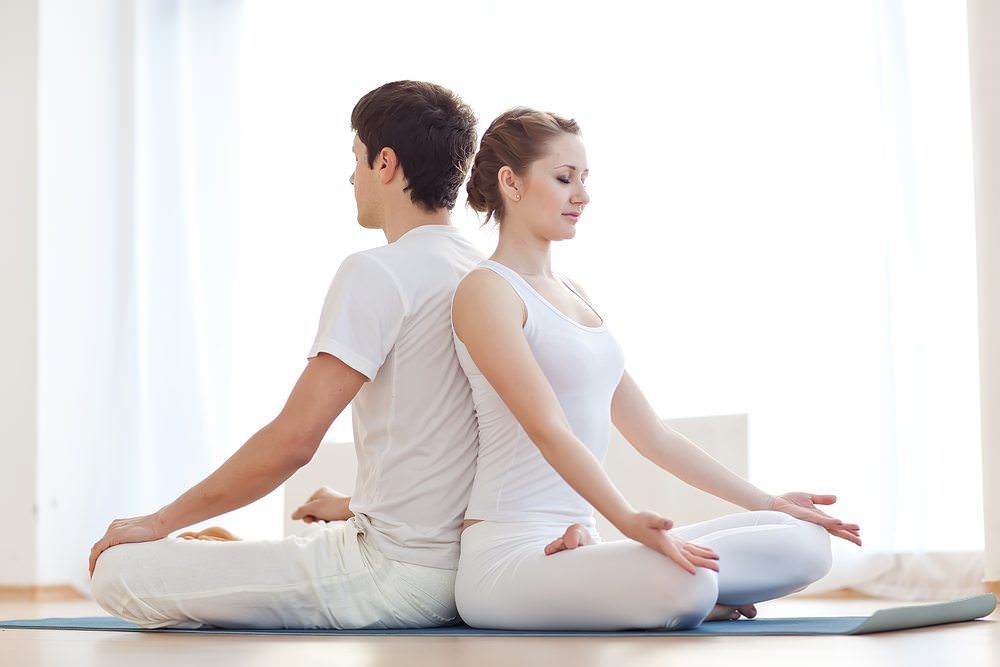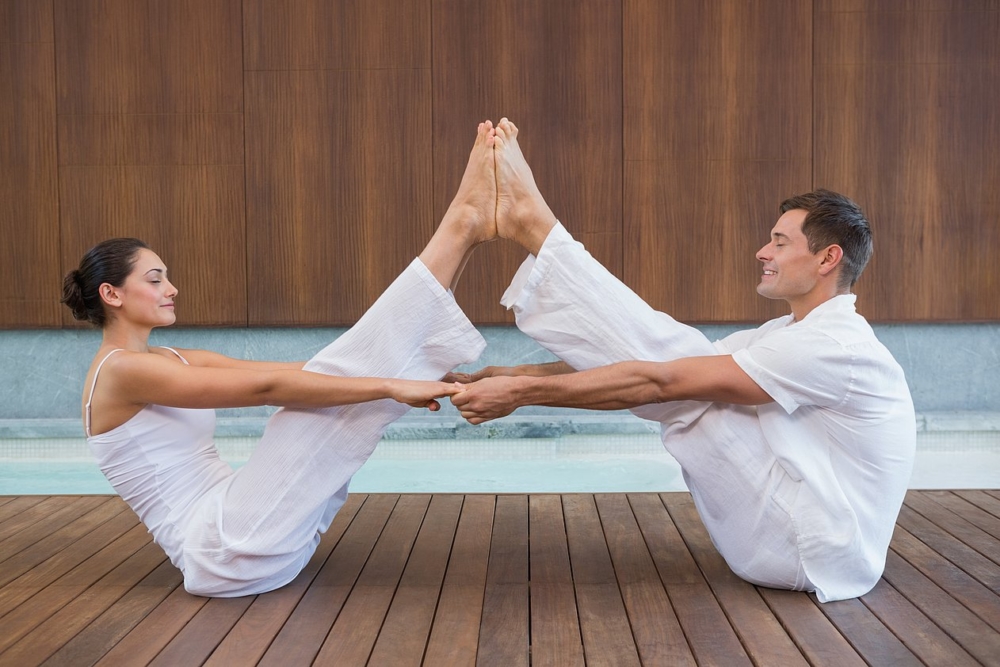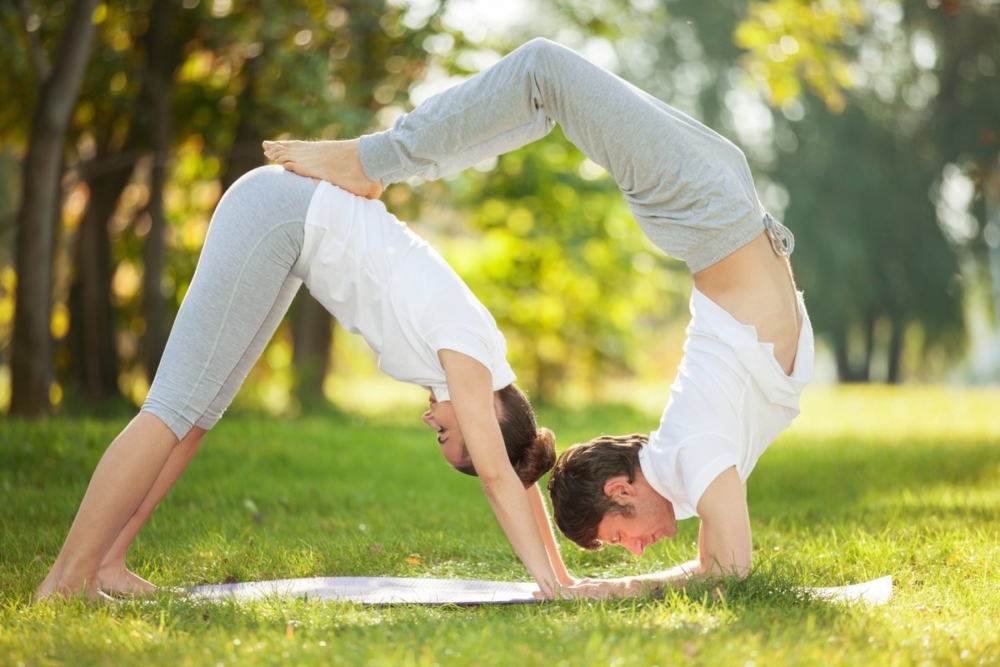With the increasing popularity of yoga, new areas of this practice are developing. One of them is yoga for two. The essence of such activities is to achieve spiritual enlightenment and unity with your partner through asanas, which help to properly distribute the person’s vital energy.
Material Content:
The benefits of pair yoga
The basis of practice is the most famous asanas of Hatha Yoga, adapted for two people to perform. This simplifies the physical component of classes, but the spiritual takes on a new meaning.
The purpose of the practice is to achieve harmony and unity in a couple. Yoga for two is especially recommended for couples whose relationship is mired in a routine, as it allows you to look at your partner differently. The benefits of pair yoga for loving people:
- strengthening a spiritual connection with a partner;
- better understanding of feelings and emotions;
- trust development;
- building harmonious relationships;
- knowledge of pure and deep love.
In addition, pair yoga effectively removes emotional stress, allows you to resolve conflicts and release insults, because it reveals the spiritual potential of a person, which means it makes him better. Do not forget that in hatha yoga, the main emphasis is on asanas that work the whole body, so such training will be an excellent form of joint leisure. Classes in a pair will benefit the body, soul, strengthen relationships.
Easy poses for beginners
Yoga for two has one interesting feature: here it is necessary to feel the partner’s energy and direct his own towards him.All asanas are simplified, because at the time of execution both partners support each other, but the spiritual component is often difficult to understand. Thus, pair yoga for beginners requires qualified assistance from an outsider who can explain, correct and direct all asanas to the correct execution, therefore it is best to deal with an instructor.
- Note! Despite the fact that pair yoga harmonizes relations, a loved one during classes should not be the object of close attention. It is necessary to learn to perceive a lover during training as a separate clot of energy, but not a person or a loved one.
Simple poses you can try to master yourself. They are easy to repeat, and the risk of injury is minimized. In addition, these positions do not require special physical training:
- "Inverted Triangle." This asana is performed while standing. Partners should stand facing each other at arm's length, legs are bent at the knees, relaxed and widely spaced. Stretch your arms up and stay in this position for 1-2 minutes. Then spread your arms wider, and unfold the body so that with one hand you can reach your toes. The second hand at this time reaches for the head. At the same time, the partner stands in the same position, pressing his back against the back of the second tandem member. Such an asana can serve to exchange energy with a partner, if you hold hands.
- "Dog face down" for two. One person spreads his legs wide, raises his hands and places them on the floor. The lower limbs do not need to bend at the knees. The second participant places his hands about 40 cm from his hands on the floor, then puts his feet on the pelvic area of a person standing in the asana and repeats it, leaning on the back of his partner.
- "Boat" for two. Both partners sit on the floor facing each other, legs wide apart and feet pressed. Then you should bring your legs together without lifting them from your partner’s feet and raise them to chest level, while spreading your arms and connecting them with the palms of the second person.
These postures prepare the muscles and can be used by experienced practitioners to warm up. In each position, you need to linger for a few minutes, feeling the movement of energy.
Difficult exercises for advanced
Experienced couples will use more complex asanas, however, they must be mastered using video lessons or during classes with an instructor. The fact is that in such exercises the whole body is involved and the risk of injury increases if improperly performed.
Recommended positions for experienced people:
- "Headstand."
- "Airplane".
- Double Cobra.
To perform a headstand, you must first take the pose “dog face down”. Then the body weight is transferred to the upper back, hands are laid under the head, and legs are lifted up. The emphasis is on the head and elbows bent at the elbows, which fix the neck. Partners become facing each other in this position, and then stretch one leg forward, connecting the feet.
Asana "Airplane" is performed as follows. A physically strong partner lies on his back, raising straight arms and legs. The second partner rests its palms on his hands, and his pelvis rests on his feet. At the same time, you need to bend your back, legs are straight, socks stretch back.
"Double cobra" requires that one partner lay on his stomach, legs tightly closed. The second person becomes so that to press the feet to the hips of the first. Then he needs to bend down, grab the hands of the lying man who stretched them back, bend his knees and bend his back so that he could lie down on the back of the head with the back of the head.
There are a lot of asanas for two. Any hatha yoga exercise can be changed for a couple or repeated symmetrically. It can turn out to be an excellent yoga challenge for two to strengthen relations: daily develop a new asana together for 7 days.
Pair yoga for children
Simple yoga poses for two can be mastered with children.Such classes bring together kids and their parents perfectly. It is important to present the child with all the exercises in a playful way, because otherwise he will quickly lose interest in this type of training:
- "Airplane". The parent lies on his back, stretches his arms and legs up. The kid grabs his hands, rests his pelvis on the parent's feet and depicts an airplane, stretching his legs back and raising his head.
- "Mountain". The parent lies on his back, raising his pelvis, and throwing his legs behind his head. At this time, the child lies with his back on the parent’s feet, grabs them with his hands, and bends his legs at the knees, resting against the floor.
- "Wood". Both participants stand straight, then press one foot against the lower leg with one foot. The parent lowers one hand, turning the palm down, and the child raises his hand, touching the adult's hand with his palm.
Children can perform paired exercises with friends or brothers and sisters. According to the instructors, joint activities with another child or parents strengthen relationships in the family.
Precautions and contraindications
When practicing yoga together, it is important to remember that the position of the body must be changed smoothly so as not to bring down the concentration of the partner. And you should also take into account your physical fitness, because the second person in a pair may simply not master difficult poses if you have never played sports before.
Do not start classes, feeling resentful of a partner or immediately after a scandal. In this case, there will be no sense in practice, but because of the general negative mood, the risk of injury increases.
Contraindications include any ailments, pregnancy, fever or muscle pain. If your well-being leaves much to be desired, it is better to give up classes on this day.
It is recommended to complete the joint training with the “corpse pose”, having settled down with the “jack” partner. After that, you can spend a joint meditation or just go for a walk in the nearest park. It is recommended to choose a quiet time for classes, when none of the partners need to hurry on business.
















